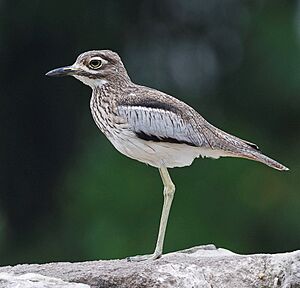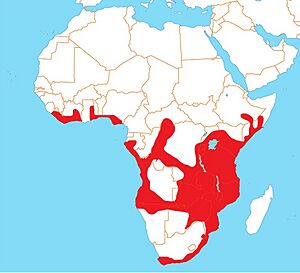Water thick-knee facts for kids
Quick facts for kids Water thick-knee |
|
|---|---|
 |
|
 |
|
| Conservation status | |
| Scientific classification | |
| Genus: |
Burhinus
|
| Species: |
vermiculatus
|
 |
|
| range | |
The water thick-knee is a special type of bird. It is also called the water dikkop. Its scientific name is Burhinus vermiculatus. This bird belongs to a family called Burhinidae. You can find water thick-knees all over Sub-Saharan Africa. They usually live near water.
Contents
Where Water Thick-knees Live
The water thick-knee lives in many countries in Africa. These include Angola, Botswana, Kenya, South Africa, and Zambia. They like to live near water sources. You can find them by lakes, rivers, and even on sheltered beaches. They also live in mangrove areas. These birds need bushes or trees nearby for shelter. They can live from sea-level up to about 1,800 meters (5,900 feet) high.
What Water Thick-knees Look Like
The water thick-knee is about 38 to 41 centimeters (15 to 16 inches) long. It weighs between 293 and 320 grams (10 to 11 ounces). This bird has a strong, thick beak. The beak is black with a yellow part near its base. Water thick-knees have wide, rounded wings. Their tail is quite short.
How Water Thick-knees Behave
The water thick-knee mostly looks for food on the ground. It hunts at night. Even though it lives near water, it can go up to 1 kilometer (0.6 miles) away to find food. It eats insects, crustaceans like crabs, and mollusks like snails.
Reproduction and Life Cycle
Water thick-knees usually lay eggs during the dry season. Sometimes they breed at the start of the rainy season. They are monogamous, meaning a pair stays together. Both parents protect their nest and eggs.
Their nest is a simple hollow in the sand or stony ground. It is usually very close to water. A female water thick-knee lays two sandy-yellow eggs. Both the male and female bird take turns sitting on the eggs. This is called incubation. It lasts for 22 to 25 days. After the chicks hatch, both parents feed them.
Amazing Partnership with Crocodiles
Water thick-knees have a very special habit. They often build their nests right next to Nile crocodile nests. Sometimes, they even nest on top of them! These two different animals help each other. This is called symbiotic mutualism.
The water thick-knee is very vocal and active. It acts like a loud guard for both nests. The powerful crocodile provides protection. If something tries to get close to the nests, the thick-knee pair will react. They spread their wings to look bigger and peck at the intruder. They try to scare it away. If they are not successful, their loud calls will alert the mother crocodile. She will then come to protect the nests.



